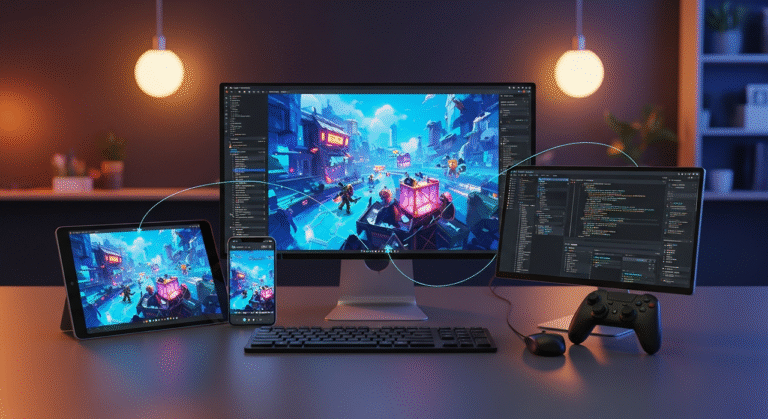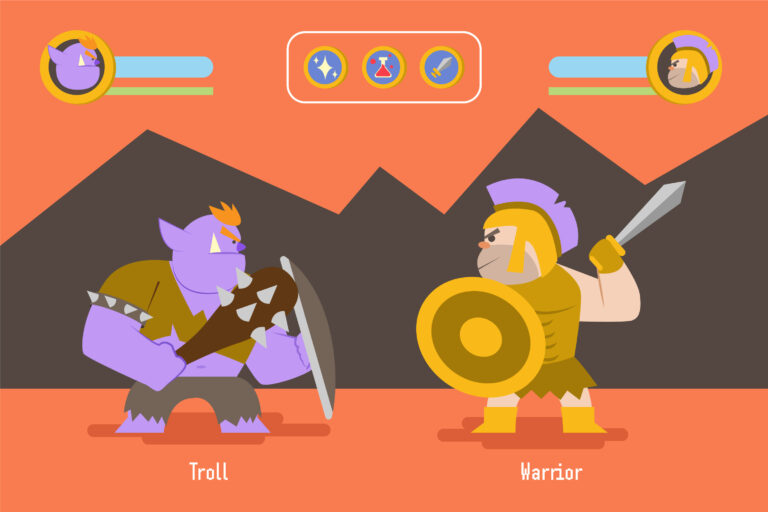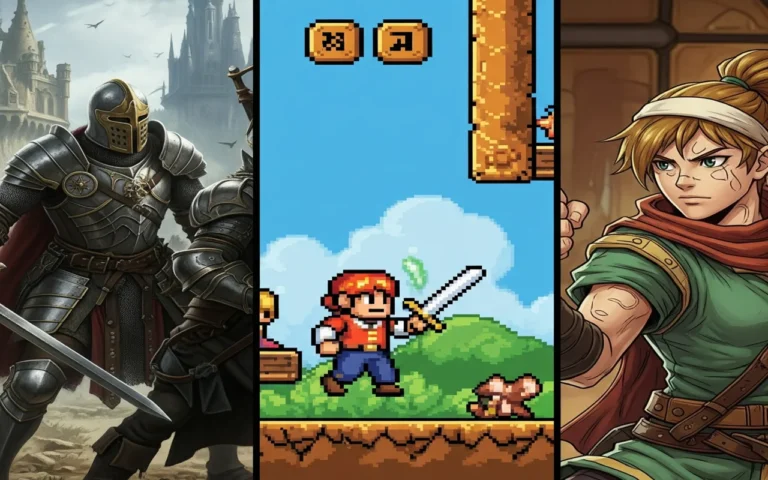Casual game art is a highly impactful visual aesthetic in today’s mobile and cross-platform games. It is simple, easy to understand, vivid, and optimized for rapid engagement; yet beneath this surface-level simplicity lies a meticulously deliberate design philosophy.
Whether you are a newcomer grasping the basics of game art or a veteran in casual game art services, understanding the principles of this art is vital for developing successful puzzle, simulation, hyper-casual, and social games.
In this guide, we will dissect the fundamental design tenets, classifications, advantages, and art direction strategies that define contemporary casual titles. Let’s examine how this style achieves a balance between visual clarity, appeal, and business viability.


Need Game Art Services?
Visit our Game Art Service page to see how we can help bring your ideas to life!
What Exactly Is Casual Game Art?
Casual game art refers to aesthetic styles engineered for broad accessibility, immediate readability, and emotional warmth. It typically incorporates gentle forms, sharp silhouettes, expressive features, and energetic character color palettes that feel inviting to a wide user base.
Rather than excessive detail, the emphasis is on simplicity that facilitates quick gameplay choices and maintains a low cognitive load.
This style is prevalent across top mobile games because it performs well on all devices, loads quickly, and connects instantly with both new and returning players. Grasping this core concept helps designers craft visuals that capture attention in mere seconds.
Core Visual Characteristics
Casual art prioritizes gentle curves, rounded shapes, minimal texture, and cartoon-inspired proportions. These features contribute to a friendly aesthetic while ensuring every object is recognized immediately.
Contrast is intentionally used to separate interactive elements from the background, and details are kept subtle to avoid clutter on small screens. Even characters are streamlined, utilizing expressive eyes and exaggerated silhouettes for rapid emotional communication.
These visual traits explain why the style translates perfectly into fast, easily accessible gameplay.
Why Casual Art Dominates Mobile and Hyper-Casual Markets
The mobile and hyper-casual game markets rely on rapid onboarding, broad accessibility, and immediate visual clarity. Casual art fulfills all three requirements.
The style loads efficiently even on lower-end devices, making it ideal for a wide global audience. Its familiar appearance also lowers resistance for players of all ages, boosting both install rates and retention.
This visual method has been proven more effective than more complex styles in ad creatives and app store screenshots, directly impacting ASO results.
How Is Casual Game Art Designed and Styled?
Designing casual art necessitates balancing straightforwardness with expressiveness. Artists employ clean shapes, controlled color palettes, and exaggerated forms to ensure every element is legible in motion.
The style is deliberately forgiving; objects do not require photorealistic intricacy; they need emotional clarity and instant recognition. Casual art also uses modular asset creation, enabling teams to generate large numbers of game-ready assets while maintaining consistency swiftly.
Shape Language and Readability
Robust shape language is the foundation of casual art. Circles suggest friendliness, squares imply stability, and triangles contribute energy or tension.
Each shape is selected to rapidly guide player interpretation, especially in puzzle or interactive environments. Silhouettes must remain instantly recognizable, even at reduced sizes.
Color Choices and Emotional Impact
Casual games rely on bright, clean colors that elicit positive emotions. Designers utilize carefully chosen palettes that maintain high contrast for gameplay clarity while preventing visual fatigue.
Based on color theory in game art, warm colors attract attention, cool colors stabilize the environment, and gradients provide subtle appeal without creating clutter.
Animation Style in Casual Games
Animation in casual games is quick, lively, and expressive. Motion exaggeration, squash and stretch, and rhythmic timing endow even basic characters with personality.
These animations are not merely decorative; they serve UX functions such as providing feedback, offering rewards, and providing timing cues in puzzle sequences.
What Types of Games Use Casual Art?
Casual art is flexible enough to appear across numerous video game genres. Its readability and charm make it perfect for puzzle games, idle simulations, light strategy titles, and hyper-casual experiences.
Developers opt for this style because it appeals to audiences who favor quick sessions, intuitive interfaces, and visually engaging loops. Let’s explore how the style adapts to various categories:
Puzzle & Match-3
Match-3 and puzzle games require instant recognition of shapes, icons, and boosters. Casual art guarantees that tiles, power-ups, and obstacles are easy to discern, even during fast chain reactions.
This clarity is vital for maintaining flow and reducing player frustration.
Simulation & Idle Games
In idle simulators, casual art provides a welcoming world with simple assets that scale easily as players expand their environment. It is effective for farming, tycoon, city-building, and crafting systems.
The approachable style keeps these progression-focused games feeling light and rewarding.
Strategy-Light & Social Games
These titles employ casual aesthetics to reduce the intimidation often associated with strategy titles. Characters remain expressive, menus are colorful, and environments stay readable.
This fosters a welcoming atmosphere even for competitive gameplay.
Hyper-Casual Experiences
Hyper-casual games require art that is instantly understandable in advertisements. Clean shapes and exaggerated objects deliver precisely that.
This hyper-casual UI/UX design helps these games achieve high install rates with minimal visual complexity.
What Defines Strong UI/UX in Casual Game Graphics?
Strong UI/UX design in casual games is characterized by intuitive layouts, decipherable icons, and responsive visuals that naturally guide players.
Designers create interfaces that feel airy, friendly, and effortless to navigate. Every component, from buttons to tooltips, must be optimized for mobile screens and thumb reach.
Clear visual feedback (flashes, pops, sparkles, micro-animations) ensures players always understand the outcome of their actions. To achieve this, UI/UX relies on three primary visual components:
- Iconography and Micro-Visuals: Icons must be straightforward, bold, and readable at small scales. Micro-visuals like sparkles, pulses, and subtle glows help emphasize interactive elements and reinforce reward moments.
- Layout, Flow, and Touch Interaction: Mobile-first layout ensures menus are easy to reach and navigate with one hand. Flow must feel natural, with clear paths between gameplay, shop screens, progression, and rewards.
- Visual Feedback and Player Rewards: Animations, particle effects, and color shifts reinforce player actions. Reward feedback, like coin bursts or chest-opening effects, creates emotional payoff.
What Should Designers Consider When Creating Casual Game Art?
Designers must understand audience psychology, platform limitations, and production pipelines. Casual players anticipate low-friction visuals, smooth animations, and immediate clarity.
The art must scale effectively across different devices and be sufficiently modular to support frequent updates or live ops events. Three factors guide the production process:
Player Psychology and Cognitive Load
Casual players prefer swift comprehension. Avoiding clutter, maintaining high contrast, and using familiar shapes reduces cognitive load and improves retention. Simplicity supports long-term engagement.
Art Production Pipelines for Small Teams
Casual games are frequently built by small art teams. Utilizing modular assets, shared color palettes, and reusable animation rigs accelerates output without sacrificing quality. Efficient pipelines help teams ship updates consistently.
Platform Constraints (Mobile, Web, Cross-Platform)
Assets must be lightweight to load quickly and perform smoothly. Designers must consider memory usage, texture resolution, and compatibility across Android, iOS, and WebGL.
What Are the Advantages of Using Casual Art Style?
Casual art offers rapid production, extensive demographic appeal, and strong marketing performance. Its simplicity reduces rendering costs, shortens iteration cycles, and supports A/B testing in ads and store assets.
The style also adapts well to seasonal events and live-ops updates because it is flexible and easy to modify.
Let’s examine the core benefits:
- Faster Production Cycles: Simple shapes and limited textures mean faster modeling, illustration, and animation. This reduces overall game development costs and accelerates content releases.
- Wider Audience Appeal: Casual visuals attract players of all ages, cultures, and skill levels. This inclusivity makes the style perfect for global markets.
- Marketing and ASO Benefits: Clean, colorful visuals outperform complex art in ads and screenshots. Casual art helps players understand gameplay instantly, improving both click-through and conversion rates. This makes it one of the strongest styles for user acquisition.
What Are the Advantages of Using Casual Art Style?
Art direction in game development ensures every asset, animation, and UI element feels cohesive. A strong art director defines the game’s visual identity, color language, character style, and emotional tone.
They maintain consistency across updates, collaborate with designers on visual storytelling, and ensure the art remains aligned with gameplay objectives.
- Creating a Visual Identity: Visual identity includes shapes, colors, characters, and world-building elements that distinguish a game. A strong identity improves recognizability in ads and thumbnails. Iconic visuals support long-term brand value.
- Consistency Across Updates and Live-Ops: Casual games rely on frequent events, seasonal themes, and new levels. Art direction keeps everything stylistically consistent while still introducing novelty.
- Working With External Art Teams or Outsourcing: Many studios outsource illustration, animation, or UI. Clear art direction guides external teams to deliver assets that feel cohesive with the core experience.
Efficient collaboration with a game art outsourcing studio enables a smoother workflow and better outcomes.
Final Words
Casual game art is more than just an aesthetic; it is a design philosophy founded on clarity, charm, and accessibility. Its power resides in its capacity to communicate instantly, support intuitive gameplay, and appeal to a vast global audience.
Whether you are creating puzzles, idle games, hyper-casual titles, or social experiences, mastering this art style helps your game succeed in competitive markets.
By applying strong UI/UX principles, understanding player psychology, and maintaining cohesive art direction, you can create visuals that are both attractive and commercially effective.









